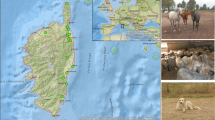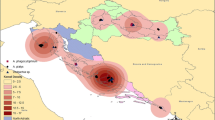Abstract
Anaplasmataceae includes the genera Anaplasma, Ehrlichia, Neorickettsia and Wolbachia, comprising a group of obligate intracellular bacteria. The genus Anaplasma has pathogenic species transmitted by ticks of veterinary and human health importance. Wild ungulates such as deer represent important reservoirs and amplifiers of Anaplasmataceae. The interaction between deer and domestic ruminants represents a serious problem due to the transmission of these pathogens through their ectoparasites. In the present study, we investigated the presence of Anaplasmataceae organisms in blood, tissues and tick samples of a gray-brocket deer (Mazama gouazoubira). The specimen was found dead in a farm in northeast Uruguay. PCRs targeting partial regions of 16S rRNA and groESL genes were carried out for Anaplasmataceae DNA detection. Moreover, several ectoparasites were identified: the chewing louse Tricholipeurus albimarginatus, the Neotropical deer louse fly Lipoptena mazamae, and the ticks Haemaphysalis juxtakochi and Rhipicephalus microplus. A consensus sequence of 1274 bp of 16S rRNA was generated for Anaplasma sp. from the M. gouazoubira blood sample. All ticks analysed by PCR assays were negative. No band was detected in any of the samples after PCR targeting groESL gene. Phylogenetic analysis using 16S rRNA partial gene sequences, clustered the putative novel genotype sequence obtained in this study, named Anaplasma sp. genotype Mazama—Uruguay, along with Anaplasma sp. detected in Mazama sp., Mazama americana and Mazama bororo, all deer species from Brazil. Furthermore, this cluster showed to be closely related to Anaplasma bovis sequences obtained from various ruminants and other mammals from several parts of the world. The pathogenicity as well as its infecting potential to other cervids or domestic ruminants is currently unknown. Further studies should be performed in order to characterize this novel species, especially targeting other genes.


Similar content being viewed by others
References
Aguiar DM (2017) Ehrlichiosis. In: Bayry J (ed) Emerging and Re-emerging Infectious Diseases of Livestock. Springer, Cham, pp 365–375
Brazeiro A, Panario D, Soutullo A, Gutierrez O, Segura A, Mai P (2012) Clasificación y delimitación de las eco-regiones de Uruguay. Informe Técnico. Convenio MGAP/PPR–Facultad de Ciencias/Vida Silvestre/ Sociedad Zoológica del Uruguay/CIEDUR, pp. 40
de la Fuente J, Ruiz-Fons F, Naranjo V, Torina A, Rodriguez O, Gortázar C (2008) Evidence of Anaplasma infections in European roe deer (Capreolus capreolus) from southern Spain. Res Vet Sci 84:382–386. https://doi.org/10.1016/j.rvsc.2007.05.018
Drummond RO (1966) Lipoptena mazamae Rondani (Diptera: Hippoboscidae), a louse fly of deer, on cattle in southwestern Texas. J Parasitol 52(4):825
Duarte JMB, Merino ML, Gonzalez S, Nunes ALV, Garcia JM, Szabó MPJ, Pondolfi JR, Arantes IG, do Nascimento AA, Machado RZ, Araujo Jr JP, Catao-Dias JL, Werther K, Garcia JE, Girio RJS, Matushima ER (2001) Order Artiodactyla, family Cervidae (deer). In: Fowler ME, Cubas ZS (eds.). Biology, medicine and surgery of South American Wild Animals. Iowa State University Press, pp 402–422
Dumler JS, Barbet AF, Bekker CPJ, Dasch GA, Palmer GH, Ray SC, Rikihisa Y, Rurangirwa FR (2001) combinations and designation of Ehrlichia equi and ‘HGE agent’ as subjective synonyms of Ehrlichia phagocytophila. Int J Syst Evol Microbiol 51:2145–2165. https://doi.org/10.1099/00207713-51-6-2145
Gortázar C, Ferroglio E, Höfle U, Frölich K, Vicente J (2007) Diseases shared between wildlife and livestock: a European perspective. Eur J Wild Res 53:241–256. https://doi.org/10.1007/s10344-007-0098-y
Graciolli G, Carvalho C (2003) Hippoboscidae (Diptera, Hippoboscoidea) no Estado do Paraná, Brasil: chaves de identificação, hospedeiros e distribuição geográfica. Rev Bras Zool 20(4):667–674. https://doi.org/10.1590/S0101-81752003000400019
Inokuma H, Parola P, Raoult D, Brouqui P (2001) Molecular survey of Ehrlichia infection in ticks from animals in Yamaguchi Prefecture, Japan. Vet Parasitol 99:335–339
Kocan KM, Fuente J, Guglielmone AA, Meléndez RD (2003) Antigens and alternatives for control of Anaplasma marginale infection in Cattle. Clin Microbiol Rev 16:698–712. https://doi.org/10.1128/CMR.16.4.698-712.2003
Kumar S, Stecher G, Tamura K (2016) MEGA7: Molecular Evolutionary Genetics Analysis version 7.0 for bigger datasets. Mol Biol Evol 33(7):1870–1874. https://doi.org/10.1093/molbev/msw054
Little SE, Stallknecht DE, Lockhart JM, Dawson JE, Davidson W (1998) Natural coinfection of a whitetailed deer (Odocoileus virginianus) population with three Ehrlichia spp. J Parasitol 84:897–901. https://doi.org/10.2307/3284616
Lotric-Furlan S, Petrovec M, Zupanc TA, Nicholson WL, Sumner JW, Childs JE, Strle F (1998) Human granulocytic ehrlichiosis in Europe: clinical and laboratory findings for four patients from Slovenia. Clin Infect Dis 27:424–428. https://doi.org/10.1086/514683
Machado RZ, Duarte JMB, Dagnone AS, Szabó MPJ (2006) Detection of Ehrlichia chaffeensis in Brazilian marsh deer (Blastocerus dichotomus). Vet Parasitol 139:262–266. https://doi.org/10.1016/j.vetpar.2006.02.038
Martin C, Pastoret PP, Brochier B, Humblet MF, Saegerman C (2011) A survey of the transmission of infectious diseases/infections between wild and domestic ungulates in Europe. Vet Res 42(1):70. https://doi.org/10.1186/1297-9716-42-70
de Massard C, Massard CL (1982) Ehrlichia bovis (Rickettsiales: Rickettsiaceae) em Gado de Leite no Brasil. Arq Univ Fed Rur Rio de Janeiro 5(2):237–239
Melo OA Jr, Albernaz AP, Thiebaut JTL, Miranda FJB, Machado JA, Silva ACF (2010) Ocorrência de Anaplasma bovis (Donatien & Lestoquard, 1936, Dumler et al., 2001) na região de Bom Jesus do Itabapoana RJ. Ci Anim Bras 11:888–891. https://doi.org/10.5216/cab.v11i4.5575
Mongruel AC, Benevenute JL, André MR, Carrasco AO, Machado RZ, Seki MC (2017) Molecular characterization of Anaplasma sp. in free-living gray brockets (Mazama gouazoubira). Vect Born Zoon Dis 17(3):165–171 https://doi.org/10.1089/vbz.2016.2026
Nari A, Solari MA, Cardozo H (1979) Hemovacuna para el control de Babesia spp y Anaplasma marginale en el Uruguay. Veterinaria (Montevideo) 15:137–148
Nava S, Venzal JM, González-Acuña D, Martins TF, Guglielmone AA (2017) Ticks of the Southern Cone of America: diagnosis, distribution, and hosts with taxonomy, ecology and sanitary importance. Elsevier, London, p 348
Nicholson WL, Castro MB, Kramer VL, Sumner JW, Childs JE (1999) Dusky-footed wood rats (Neotoma fuscipes) as reservoirs of granulocytic ehrlichiae (Rickettsiales: Ehrlichieae) in northern California. J Clin Microbiol 37:3323–3327
Parola P, Roux V, Camicas JL, Baradji I, Brouqui P, Raoult D (2000) Detection of Ehrlichiae in African ticks by polymerase chain reaction. Trans R Soc Trop Med Hyg 94(6):707–708. https://doi.org/10.1016/s0035-9203(00)90243-8
Picoloto G, Ferreira de Lima R, Olegário LAO, Carvalho CME, Lacerda ACR, Tomás WM, Borges PAL, Pellegrin AO, Madruga CR (2010) Real time polymerase chain reaction to diagnose Anaplasma marginale in cattle and deer (Ozotoceros bezoarticus leucogaster) of the Brazilian Pantanal. Rev Bras Parasitol Vet 19:186–188. https://doi.org/10.1590/s1984-29612010000300012
Portillo A, Pérez-Martínez L, Santibáñez S, Santibáñez P, Palomar AM, Oteo JA (2011) Anaplasma spp. in wild mammals and Ixodes ricinus from the north of Spain. Vect Born Zoon Dis 11:3–8. https://doi.org/10.1089/vbz.2009.0214
Rar V, Golovljova I (2001) Anaplasma, Ehrlichia, and “Candidatus Neoehrlichia” bacteria: pathogenicity, biodiversity, and molecular genetic characteristics, a review. Infect Genet Evol 11:1842–1861. https://doi.org/10.1016/j.meegid.2011.09.019
Sacchi AB, Duarte JM, André MR, Machado RZ (2012) Prevalence and molecular characterization of Anaplasmataceae agents in free-ranging Brazilian marsh deer (Blastocerus dichotomus). Comput Immunol Microbiol Infect Dis 35(4):325–334. https://doi.org/10.1016/j.cimid.2012.02.001
Santos CF, Carvalho CB (2006) Primeiro relato de Anaplasma bovis (Donatien & Lestoquard, 1936) Dumler et al. (2001) na microrregião de Campos dos Goytacazes, Estado do Rio de Janeiro, Brasil: nota de pesquisa. Rev Bras Parasitol Vet 15(3):126–127
Silveira JA, Rabelo EM, Ribeiro MF (2012) Molecular detection of tick-borne pathogens of the family Anaplasmataceae in Brazilian brown brocket deer (Mazama gouazoubira, Fischer, 1814) and marsh deer (Blastocerus dichotomus, Illiger. Transbound Emerg Dis 59(4):353–360. https://doi.org/10.1111/j.1865-1682.2011.01278.x
Silveira JAG, Rabelo EML, Lima PCS, Chaves BN, Ribeiro MF (2014) Post-mortem hemoparasites detection in free-living Brazilian brown brocket deer (Mazama gouazoubira, Fischer 1814). Braz J Vet Parasitol 23:206–215. https://doi.org/10.1590/s1984-29612014035
Soares HS, Marcili A, Barbieri ARM, Minervino AHH, Malheiros AF, Gennari SM, Labruna MB (2017) Novel Anaplasma and Ehrlichia organisms infecting the wildlife of two regions of the Brazilian Amazon. Acta Trop 174:82–87. https://doi.org/10.1016/j.actatropica.2017.07.006
Solari MA, Nari A, Cardozo H (1992) Impact of Babesia bovis and Babesia bigemina on the production of beef cattle in Uruguay. Mem Inst Oswaldo Cruz 87:143–149. https://doi.org/10.1590/s0074-02761992000700022
Sumner JW, Nicholson WL, Massung RF (1997) PCR Amplification and Comparison of Nucleotide Sequences from the groESL Heat Shock Operon of Ehrlichia Species. J Clin Microbiol 35:2087–2092
Weisburg WG, Bams SM, Pelletier DA, Lane DJ (1991) 16S Ribosomal DNA amplification for phylogenetic study. J Bacterial 173:679–703. https://doi.org/10.1128/jb.173.2.697-703.1991
Werneck FL (1950) Os Malófagos de Mamíferos. Parte II: Ischnocera (continuação de Trichodectidae) e Rhyncophthirina. Instituto Oswaldo Cruz, Rio de Janeiro, pp. 207
Yang J, Li Y, Liu Z, Guan G, Chen Z, Luo J, Wang X, Yin H (2014) Molecular evidence for Anaplasma bovis Infection in Wild Reeves' Muntjac (Muntiacus reevesi) Southwest China. J Wildlife Dis 50(4):982–985. https://doi.org/10.7589/2013-08-224
Yoshimoto K, Matsuyama Y, Matsuda H, Sakamoto L, Matsumoto K, Yokoyama N, Inokuma H (2010) Detection of Anaplasma bovis and Anaplasma phagocytophilum DNA from Haemaphysalis megaspinosa in Hokkaido, Japan. Vet Parasitol 168:170–172. https://doi.org/10.1016/j.vetpar.2009.10.008
Acknowledgements
We would like to thank Hugo Pereda (farm owner), Ricardo Palle (farm manager) and his family for kindly providing the specimen for this study.
Funding
We would like to thank Comisión Sectorial de Investigación Científica (CSIC), Programa Iniciación a la Investigación 2017, Project ID 160 for the financial support to MLF.
Author information
Authors and Affiliations
Corresponding author
Ethics declarations
Conflict interests
The authors declare no competing interests in the study.
Additional information
Publisher's Note
Springer Nature remains neutral with regard to jurisdictional claims in published maps and institutional affiliations.
Rights and permissions
About this article
Cite this article
Félix, M.L., Armúa-Fernández, M.T., Parodi, P. et al. Detection of a putative novel genotype of Anaplasma in gray-brocket deer (Mazama gouazoubira) from Uruguay. Exp Appl Acarol 81, 575–583 (2020). https://doi.org/10.1007/s10493-020-00523-0
Received:
Accepted:
Published:
Issue Date:
DOI: https://doi.org/10.1007/s10493-020-00523-0




